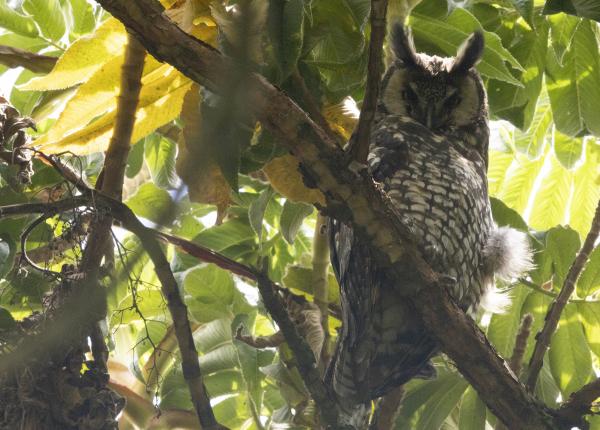Did you know:
- Very little is known about the Abyssinian Owl's diet, breeding or behavior - making it the perfect species for a budding biologist to study.
- This owl is also known as the African Long-eared Owl.
- There are two recognized subspecies of the Abyssinian Owl, one which is endemic to the highlands of Ethiopia.
How The Peregrine Fund is Helping
Though The Peregrine Fund does not work directly with the Abyssinian Owl currently, our efforts in scientific research, habitat conservation, education, and community development help conserve birds of prey around the world. We also supply literature to researchers from our avian research library, which helps scientists around the world gather and share important information on raptor conservation. Through the Global Raptor Impact Network, we help monitor and conserve the world’s raptors, while giving raptor researchers tools to more efficiently conduct their own studies while contributing to a global program.
Where They Live
The Abyssinian Owl is found in parts of eastern Africa, including in some forests of Ethiopia, northern Kenya, Uganda and Rwanda. It is found in a variety of habitats including highlands, montane forest, grasslands, and exotic Eucalyptus stands.
What They Do
The Abyssinian Owls is sometimes known as the Abyssian Long-eared Owl. It gets this name from the large "ear tufts" that stick out from its head, giving it the appearance of having ears. However, these feathered tufts aren't ears at all. They are simply feathers that help with camouflage and possibly communication.
And speaking of ears... these owls, like many other owls, have asymmetrical ear openings. This means that one ear opening is located higher up on one side of the head, while the other ear opening is located lower on the other side of the head. There can also be one ear opening that is a bit farther forward on the head while the ear opening on the other side of the head is a bit farther back. The ear positions can be any combination of high, low, forward, and back! This helps owls better triangulate sounds, thus finding prey that much easier.
Similar in appearance to the Long-eared Owl, the Abyssinian Owl is mottled all over. Its breast and belly, back, head and wings are a rich brown color and are widely covered in a mosaic of feathers that range in color from cream to rust.
It has piercing eyes. The bill is black. Its legs are feathered. It has a light brown facial disk that is lined with a blackish rim. To learn more about what a facial disk is and what it does, continue reading about this owl's diet!
Like many raptors, these owls are top predators—they hunt other animals for food but no animals hunt them on a regular basis. For most top predators, their only threat is humans. Top predators, such as the Abyssinian Owl, play an important role in nature by helping to control populations of prey animals and maintain a balance in the ecosystems where they live.
This species is strictly nocturnal, meaning it is only active at night.
Why They Need our Help
The Abyssinian Owl is categorized as Least Concern, which means scientists aren't worried about this species' population at least for the immediate future. However, there is still so much to be learned about this species that it could be facing threats we aren't even aware of, including habitat loss and fragmentation.
What They Eat
This owl eats small mammals such as mice and shrews, small birds, and invertebrates. Abyssinian Owls are silent hunters that use their keen eyesight and hearing to locate and capture prey. Like other owls, and some other raptors, they are equipped with a facial disk, a group of feathers around their heads that helps direct sound to their ears. To get an idea of how it works, cup your hands behind your ears and listen—sounds will be louder and clearer. Owls can raise these feathers slightly when on the hunt, allowing them to hear the rustle of a mouse in the grass, the flapping of feathers in the night, or the slithering of a snake on a tree branch. These sounds give away the location of prey animals, making it easy for these owls to deftly swoop in to catch a meal.
Like many other owl species, it will swallow smaller prey items such as rats, whole—bones, teeth, tails and claws, and fur or feathers. As you can imagine, some of these items might be difficult to digest, even for an owl. All those undigestible bits are regurgitated in the form of a pellet. The pellet is oblong in shape and usually covered with undigested fur or feathers. Inside, bones, teeth and nails can be found. In fact, in some owl pellets scientists (and students, too) have been able to find the entire skeleton of the owl's prey!
Nests, Eggs and Young
Like many owl species, the Abyssinian Owl doesn't build its own nest. Instead it uses abandoned nests built by other birds. Apart from this basic information, very little is known about the breeding habits of this species.
Abyssinian Long-eared Owl and the World Center for Birds of Prey
The visitor center at our World Center for Birds of Prey includes owls among its avian ambassadors, including an Eurasian Eagle-owl and a Verreaux's Eagle-owl. This is a great chance to see owls up close and learn about the wonderful and interesting adaptations they have in order to survive in their respective habitats. There is also a touch table with owl feathers and other natural objects available for exploration.
Resources:
BirdLife International 2016. Asio abyssinicus. The IUCN Red List of Threatened Species 2016: e.T22689512A93233846. https://dx.doi.org/10.2305/IUCN.UK.2016-3.RLTS.T22689512A93233846.en. Downloaded on 14 April 2020.
Olsen, P.D. & Marks, J.S. (2020). African Long-eared Owl (Asio abyssinicus). In: del Hoyo, J., Elliott, A., Sargatal, J., Christie, D.A. & de Juana, E. (eds.). Handbook of the Birds of the World Alive. Lynx Edicions, Barcelona. (retrieved from https://www.hbw.com/node/55126 on 11 April 2020).










